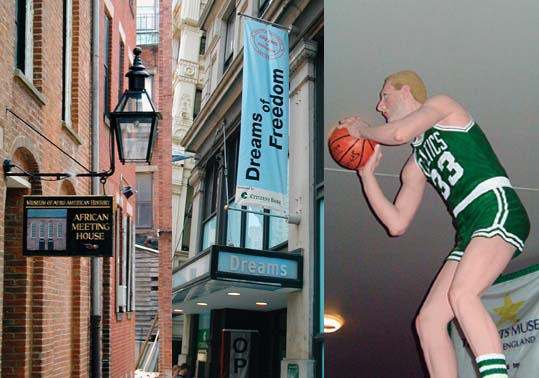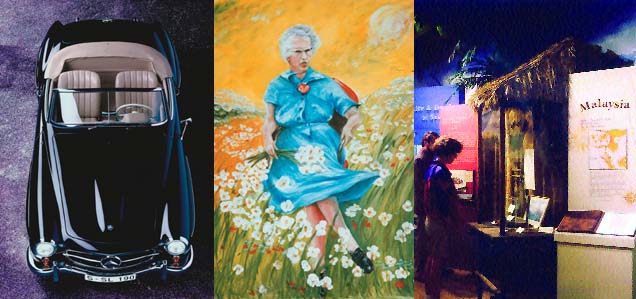
Discover Boston’s treasure trove of mini-museums,
offering facts and fun in intimate and often unlikely settings
by Panorama Staff
photos: Kristin Kammerer
| Visitors to Boston know all about Beantown’s museum biggies—the encyclopedic Museum of Fine Arts, the cavernous Museum of Science, the stunning Kennedy Library and Museum. But did you know that inside the FleetCenter, home to Boston’s Celtics and Bruins, there’s a museum that honors the Bay State’s superstar sports legends like Ted Williams and Larry Bird? Or that you can visit the original Samuel Adams microbrewery (the Boston Beer Museum) in Jamaica Plain, where you’ll discover the history of beer-making in Beantown? If you’ve already slogged from one historic site to the next along the Freedom Trail or quacked yourself hoarse on a Duck Tour, perhaps it’s time for a unique spin on history and the arts. There’s a wealth of small museums around town—many of them obscure and infrequently visited—where you can learn local lore on a more intimate scale or glimpse artwork that you won’t find in the city’s more staid museums. There’s the Boston Fire Museum, documenting some of the Hub’s most devastating blazes, or the Museum of Bad Art, which playfully mocks artists whose attempts at greatness fell woefully short. Moreover, you won’t have to struggle through endless crowds or pay exorbitant ticket prices. As the age-old adage goes: good things do come in small packages. —C.W. |
Boston Beer Museum
30 Germania St., Jamaica Plain, 617-522-9080.
In 1985, Jim Koch revolutionized the American beer industry with his
introduction of Samuel Adams Boston Lager, a craft brewed creation
that sparked the microbrewing revolution of the 1990s. The Boston
Beer Museum isn’t so much a museum as a tour of the original brewery
in Jamaica Plain, an area that was a brewing nexus in the early 20th
century. The facility is now used for research and development, but
every variety of Sam Adams is still brewed here once a year. The
tour begins with a video about the history of the Boston Beer
Company and the plant (formerly the Haffenreffer Brewery), then
moves onto the main floor to detail the intricate brewing process.
The best part of the journey, though, is its conclusion—when
visitors head for the tavern-style tap rooms to sample a host of
Samuel Adams beers. Take the “T” to the Stony Brook stop on the
Orange Line. —C.W.
 All-star lineup—Hidden gems on the Boston museum scene include (left to right) the Museum of Afro-American History, the Dreams of Freedom Museum and the New England Sports Museum. |
BOSTON FIRE MUSEUM
344 Congress St. Station, 617-482-1344
Instead of checking out Spider-Man at your local cineplex, pay
homage to some real heroes of the past and present at the Boston
Fire Museum. Located one block from the Children’s Museum, this
memorial offers an intriguing yet practical look at how early 20th
century firefighters extinguished blazes without the help of modern
technology. The museum features historical tools of firefighting’s
past—from hand-pulled and operated pump trucks dating back to 1868
to the actual stalls used for fire horses (which pulled trucks
before engines). The building itself dates back to 1891, and period
photographs and replicas chronicle some of the city’s most
devastating blazes, including the disastrous Coconut Grove nightclub
fire of 1942 and the 1964 Bellflower Street fire. Open Sat noon–4
p.m. or by appointment. Free admission. —N.S.
Dreams of Freedom Museum
One Milk St., 617-338-6022
Boston might not be “the Hub of the Universe,” as parochial
Bostonians still like to boast, but there was a time when the city
was the second largest gateway for newcomers to America. Located
just off the Freedom Trail, the Dreams of Freedom Museum honors
Boston’s history as a key port of entry for immigrants, illuminating
the treacherous Atlantic crossing that travelers endured as well as
the obstacles they faced once they arrived. A holographic Benjamin
Franklin leads a 20-minute multimedia presentation featuring the
stories of well-known immigrants like Patrick Kennedy, Phillis
Wheatley and the infamous anarchists Sacco and Venzetti. Visitors
are then given a passport and “processed” through customs. The
family-friendly exhibits include sample citizenship test questions
and interactive computer stations where kids are given a chance to
record their families’ own immigration stories. —C.W.
Institute of Contemporary Art
955 Boylston Street, Boston, 617-266-5152
Tucked into a renovated old police station, this museum is the
oldest non-collecting contemporary arts institution in the United
States, which means that the galleries are virtually recreated with
every new show. The space at the ICA is open and inviting as the
visitor travels up a winding central stairway leading to three
display floors illuminated by natural light pouring in from several
large windows. In Boston, where history echoes in every street, the
ICA is the only museum dedicated exclusively to contemporary art,
and has presented works ranging from Pablo Picasso and Andy Warhol
to up-and-coming artists like Ellen Gallagher and Nikki Lee. —M.P.
 lost classics—(left to right) The Larz Anderson Auto Museum features classic cars; the Museum of Bad Art displays classically inept art; and the U.S.S. Constitution Museum showcases classic maritime history. |
Larz Anderson Auto Museum
Larz Anderson Park, Brookline, 617-522-6547
Before Detroit, there was New England. Most people don’t know that
the auto industry was actually born here in the Bay State in the
late 19th century before moving on to the mass-production lines of
the Midwest in the 1920s. It is also not widely known that we have a
local museum that highlights this bygone era. For a look into the
history of cars and the social impact they have had on America, take
a drive out to the idyllic Larz Anderson Auto Museum near the
Brookline Country Club. This mahogany- and marble-walled carriage
house, modeled after a French castle, boasts the oldest collection
of automobiles in the country, including at 1901 Rochet-Schneider.
The current main gallery exhibit, New England Paves the Way,
examines some of the first cars ever built, and celebrates the
museum’s 50th anniversary. —A.K.
Museum of Afro-American History
46 Joy St., 617-725-0022
Among the sites on historic Beacon Hill, from the golden dome of the
State House to the Victorian-era row houses, resides the Museum of
Afro-American History. This three-story brick schoolhouse is
dedicated to the African-American experience in New England during
the 19th century. The second floor is decorated with artifacts,
including a first-edition copy of poems by Phillis Wheatley,
America’s first slave poet, and a typesetting device used by
abolitionist newsman William Lloyd Garrison. The third floor houses
five multi-media stations that recreate the slave trade era and the
Underground Railroad. A 30-minute film describes Boston’s place in
African-American history as told through the perspective of a young
narrator. Next door is the African Meeting House, the oldest
African-American church in the country, where the abolitionist and
former slave Frederick Douglass once spoke. —J.N.
Museum of Bad Art
Dedham Community Theater, 580 High St., 781-326-0409
The adage “one person’s trash is another’s treasure” could be the
mantra of the Museum of Bad Art, submerged in the basement of Dedham
Community Theatre in suburban Boston. Founded in 1993 by Scott
Wilson, who plucked the museum’s centerpiece Lucy in the Field with
Flowers from a garbage pile on a Boston street, MOBA giddily
glorifies all that’s wonderful and dreadful about bad art. It exalts
the creative process, even if the artists’ creation is an utter
failure. Giving the godawful a good name, the museum has burgeoned
into a full-time enterprise showcasing some 45 pieces which change
several times a year. The descriptions that accompany each painting
are as gut-busting as the artwork itself. But you won’t find any
Velvet Elvises or Bob Ross’ “happy little trees” here. The museum
eschews kitsch in all its forms. And you won’t stumble upon any lost
treasures either, although the abominable art displayed will make
you appreciate the real deal even more. —C.W.
SPORTS MUSEUM OF NEW ENGLAND
5th and 6th floors of FleetCenter, Causeway St., 617-787-7678
The FleetCenter, the basketball and hockey arena that’s home to
Boston’s Celtics and Bruins, is also the site of a little-known
museum honoring New England’s greatest sports champions. Legends
like Larry Bird, Ray Bourque and Bobby Orr are prominently
displayed, but little guys like “Mo” Harrington, Jr.—a Boston Garden
usher for 56 years—also find a place among the memorabilia. The old
Garden, replaced by the FleetCenter in 1995, is depicted with utmost
reverence, featuring exhibits of the arena’s seats, penalty boxes
and pieces of the Celtics’ creaky old parquet floor. The Armand L’a
Montagne solid wood sculptures are probably the museum’s crown
jewels. You can almost hear the crack of Ted Williams’ bat in his
engraving. Other highlights include exhibits on venerable Hub sports
traditions like the Head of the Charles Regatta, the Boston Marathon
and the Beanpot Hockey Tournament. —N.S.
U.S.S. CONSTITUTION MUSEUM
22 Charlestown Navy Yard on the Freedom Trail, 617-426-1812
After descending from the world’s oldest commissioned warship, “Old
Ironsides,” stroll across the dock and take an in-depth look at the
ship’s history at the U.S.S. Constitution Museum, located in the
Charlestown Navy Yard. Inside the museum are displays and
interactive exhibits detailing the vessel’s construction and
history, as well as anecdotes about the ship and its crews that will
delight even novice history buffs. You can even fire a
cannon—electronically, that is! —N.S.

back to homepage